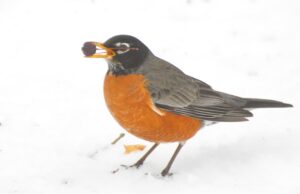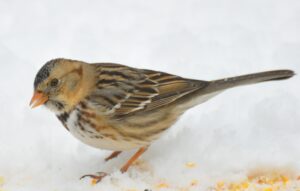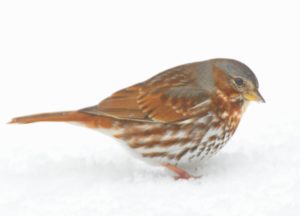Photography courtesy of Lowell Washburn, all rights reserved.
It’s an old familiar phrase that can apply to a lot of things. This week, it applied to backyard birding.
Following a complete snow melt and solid string of spring-like temperatures, backyard bird activity had declined. Feeders that had enjoyed popularity through the cold weather winter months had become predictably quiet. Only a half dozen or so bird species continued to appear daily. Even these visits had become increasingly sporadic as birds seemed more interested in what they could find under last year’s leaf litter than in anything I had to offer. Nothing unusual. Happens every year about this time.

But then, during the wee hours of Monday morning, conditions changed dramatically. A forecasted winter storm system had arrived in Iowa, dumping a predicted five to eight inches of heavy, moisture laden snowfall. Although much of the white stuff melted on contact, around four inches of the heavy duty precip managed to accumulate atop local landscapes.
No one likes wet, spring snowfall. For area wildlife, it had undoubtedly been a long cold night. But wild birds are admirably adapted to locating adequate food sources. And as quickly as daylight arrived, hungry storm-tossed birds began arriving for a handout. To keep up with the increasing demand, I topped off the hanging feeders and distributed a liberal helping of cracked corn and sunflower atop the dense layer of new snow. Although the morning skies remained dark and gusty, more and more feathered visitors continued streaming into view.

By eight o’clock, incoming bird traffic had escalated to the point that hanging feeders were loaded while the ground below was literally covered in foraging birdlife – more birds than I’d ever seen at one time during the entire winter. The half dozen species of regular visitors had more than doubled, and I began to make a list of new arrivals. The inventory steadily grew — a trio of brown headed cowbirds, five species of sparrows, pine siskins, followed by a colorful assortment of purple, gold, and house finches. Temporarily grounded by the weather, a mixed flock of migrating redwings, grackles, and rusty blackbirds dropped in to crash the party, quickly adding three more species to the growing list.

The tally ended with a total of 23 separate bird species. Considering the total numbers involved in the storm induced feeding frenzy, I could have easily missed a bird or two. But regardless of whether I listed them all or not, there was no denying that it had been a remarkable day; proof positive that Iowa birding is a lot like Iowa weather. You just never know what’s coming next.


 Tom Cope
Tom Cope Sue Wilkinson
Sue Wilkinson Susan Judkins Josten
Susan Judkins Josten Rudi Roeslein
Rudi Roeslein Elyssa McFarland
Elyssa McFarland Mark Langgin
Mark Langgin Adam Janke
Adam Janke Joe Henry
Joe Henry Kristin Ashenbrenner
Kristin Ashenbrenner Joe Wilkinson
Joe Wilkinson Dr. Tammy Mildenstein
Dr. Tammy Mildenstein Sean McMahon
Sean McMahon